
 |
|
“From that moment on, I remember Pat Kuppens as a touchstone, or maybe a portal, to my own most real self. It might sound funny to put it this way, but this is how it felt. She seemed to me to have one foot in the world she and I were both trying to cope with—the world of Yale University, of intellect and sharpness, knowledge, articulateness, ideas—and she handled this world beautifully, because of her stunning intelligence—and yet she also had one foot in...another world. This other world was the one I couldn’t quite know. I could sense it, but not know it.”
Harriet Scott Chessman,
Mother Abbess' beloved friend and fellow Yale graduate student |

 On February 1, 2015 Reverend Mother Lucia Kuppens, O.S.B. was elected the 3rd Abbess of the Abbey of Regina Laudis. Mother Lucia is a student and lover of Shakespeare with a Ph.D. in English from Yale University. She has been coordinator of the Monastic Studies and Monastic Internship Programs of the Abbey for almost thirty years. Mother Lucia has always insisted that intellectual life be grounded in the practicals of everyday incarnational life. She has been Cellarer of the Abbey, responsible for the maintenance of the Abbey property and buildings since 2001. Her day to day experience of our growing community trying to live within inadequate space and facilities, inspired her to propose our New Horizons renovation project for which she is Monastic Project Manager. Abbess Emerita David Serna has long acknowledged Mother Lucia's "comprehensive vision" which has predilected her now as "Mother Abbess" to lead Regina Laudis into the future. On February 1, 2015 Reverend Mother Lucia Kuppens, O.S.B. was elected the 3rd Abbess of the Abbey of Regina Laudis. Mother Lucia is a student and lover of Shakespeare with a Ph.D. in English from Yale University. She has been coordinator of the Monastic Studies and Monastic Internship Programs of the Abbey for almost thirty years. Mother Lucia has always insisted that intellectual life be grounded in the practicals of everyday incarnational life. She has been Cellarer of the Abbey, responsible for the maintenance of the Abbey property and buildings since 2001. Her day to day experience of our growing community trying to live within inadequate space and facilities, inspired her to propose our New Horizons renovation project for which she is Monastic Project Manager. Abbess Emerita David Serna has long acknowledged Mother Lucia's "comprehensive vision" which has predilected her now as "Mother Abbess" to lead Regina Laudis into the future.
EARLY LIFE 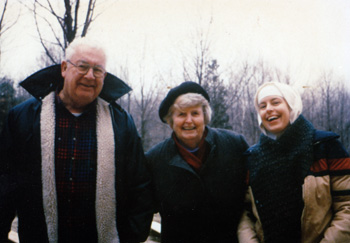 Patricia Frances Kuppens was born on December 8, 1951 the second of six children born to her parents Eleanor and Frank in Milton, Massachusetts, a pleasant and safe place to grow up, just south of Boston. Being part a of lively, loving family with three sisters (Mary, Ellen, and Martha) and two brothers (Michael and John) was no doubt an invaluable preparation for the fraternal fray of community life in a monastery. The fact that as of this writing Frank, aged 98, and Eleanor, aged 94, have every intention of attending the Abbatial Blessing testifies to the indomitable family spirit and their love of life. From their marriage of over sixty years, comes an inner sense of stability that they imparted to all their children, and which has been another asset for the monastic life. Though Patricia’s news that she wanted to enter the monastery was initially hard for everyone in the family, they were able to take the leap with her and now see the Regina Laudis community as part of their extended family. Patricia Frances Kuppens was born on December 8, 1951 the second of six children born to her parents Eleanor and Frank in Milton, Massachusetts, a pleasant and safe place to grow up, just south of Boston. Being part a of lively, loving family with three sisters (Mary, Ellen, and Martha) and two brothers (Michael and John) was no doubt an invaluable preparation for the fraternal fray of community life in a monastery. The fact that as of this writing Frank, aged 98, and Eleanor, aged 94, have every intention of attending the Abbatial Blessing testifies to the indomitable family spirit and their love of life. From their marriage of over sixty years, comes an inner sense of stability that they imparted to all their children, and which has been another asset for the monastic life. Though Patricia’s news that she wanted to enter the monastery was initially hard for everyone in the family, they were able to take the leap with her and now see the Regina Laudis community as part of their extended family.
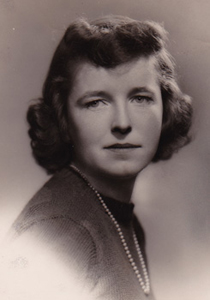 Her mother Eleanor, of Irish descent and a lover of books, introduced Patricia at an early age
to the pleasure and wisdom found in great literature. Eleanor's capacity for friendship and faithfulness to those she has known her whole life is legendary. Perhaps this is something Mother Abbess Lucia shares with her, for several early friends from Milton are with her in the Abbey now or relate to the Abbey as dedicated Oblates. Frank Kuppens was a lineman and then supervisor at the Boston Edison Company. He is proud to have been the very first lineman to be raised in a bucket to a power line. Blizzards and hurricanes found Mr. Kuppens out all nightlong working to restore power to the houses of Massachusetts. Frank was rumored to be able to fix anything and as a result a great favorite in the neighborhood, especially with the ladies. Her mother Eleanor, of Irish descent and a lover of books, introduced Patricia at an early age
to the pleasure and wisdom found in great literature. Eleanor's capacity for friendship and faithfulness to those she has known her whole life is legendary. Perhaps this is something Mother Abbess Lucia shares with her, for several early friends from Milton are with her in the Abbey now or relate to the Abbey as dedicated Oblates. Frank Kuppens was a lineman and then supervisor at the Boston Edison Company. He is proud to have been the very first lineman to be raised in a bucket to a power line. Blizzards and hurricanes found Mr. Kuppens out all nightlong working to restore power to the houses of Massachusetts. Frank was rumored to be able to fix anything and as a result a great favorite in the neighborhood, especially with the ladies.  His genealogical roots go back to the tiny village of Leiderschiedt, in Alsace, a town virtually on the border between France and Germany that has passed back and forth between the two countries for centuries following armed conflicts and border disputes. When Mother Lucia had the rare opportunity to stand on that border in Leiderschiedt in 1998 with Mother Noella Marcellino, O.S.B., who was studying in France at that time, it was easy to imagine that her genealogical roots prepared her for the future role of mediation she has often taken in community life. His genealogical roots go back to the tiny village of Leiderschiedt, in Alsace, a town virtually on the border between France and Germany that has passed back and forth between the two countries for centuries following armed conflicts and border disputes. When Mother Lucia had the rare opportunity to stand on that border in Leiderschiedt in 1998 with Mother Noella Marcellino, O.S.B., who was studying in France at that time, it was easy to imagine that her genealogical roots prepared her for the future role of mediation she has often taken in community life.
EDUCATION Pat loved school from the first day she discovered it and that love rarely deserted her. After graduating first in her class at Archbishop Williams High School in Braintree, Massachusetts, she received a substantial scholarship from the Procter and Gamble company to attend Connecticut College in New London, Connecticut, where she graduated Summa Cum Laude in 1973 with a Bachelor of Arts degree in English. While at Connecticut College she was honored as a Winthrop Scholar (enrolled in Phi Beta Kappa in her junior year) and upon graduation received the John Edwin Wells Memorial Prize in English. Her Honors Thesis was entitled: Hemingway’s Style and the Rage for Order. These college honors would be followed by the reception of a prestigious Danforth Fellowship. When first recommended to apply for the fellowship by an English professor at Connecticut, Pat had hesitated because it was oriented toward those who wanted to teach at the university level and she wasn’t totally convinced that’s what she wanted to do.  But she applied in good faith, received the fellowship, and left it to the Holy Spirit to see where it would lead her. The immediate miracle was that it provided full tuition and expenses for her to pursue a Ph.D. in English Language and Literature at Yale University. In her dissertation entitled: Patterns of Complementarity: Masculine and Feminine Relationships in Othello, King Lear and Macbeth, she explored the failure or loss of relationship between men and women in these three tragedies in light of the larger conflict of the masculine and feminine principles as defined by Carl Jung. During this time she was privileged to work closely with Mother Dolores Hart, O.S.B., the Abbey’s Dean of Education, who shared her love of Shakespeare and mentored her in the principles of complementarity. Today her perspective on any situation is still informed by these years of study. Now it is the unfolding drama of the community she is trying to “read,” seeing in opposing views the possibility of greater wholeness through discovering their complementarity. But she applied in good faith, received the fellowship, and left it to the Holy Spirit to see where it would lead her. The immediate miracle was that it provided full tuition and expenses for her to pursue a Ph.D. in English Language and Literature at Yale University. In her dissertation entitled: Patterns of Complementarity: Masculine and Feminine Relationships in Othello, King Lear and Macbeth, she explored the failure or loss of relationship between men and women in these three tragedies in light of the larger conflict of the masculine and feminine principles as defined by Carl Jung. During this time she was privileged to work closely with Mother Dolores Hart, O.S.B., the Abbey’s Dean of Education, who shared her love of Shakespeare and mentored her in the principles of complementarity. Today her perspective on any situation is still informed by these years of study. Now it is the unfolding drama of the community she is trying to “read,” seeing in opposing views the possibility of greater wholeness through discovering their complementarity.
The fate of the relationships in these plays (Othello, King Lear and Macbeth) is altogether starker and more disturbing than in Romeo and Juliet or Anthony and Cleopatra, where the hero and heroine take their lives in order to enjoy the oneness that eluded them in life. No resolution, no transcendence or hope of consummation mitigates the hero's sense of separation and separateness, of discontinuity, disconnection, loss, and despair. One cannot escape the fact that the relation of man to woman—or rather the failure of that relationship—is central to each of these three plays. Introduction to Mother Abbess Lucia's Dissertation
ARRIVAL AT REGINA LAUDIS Pat Kuppens first came to Regina Laudis in early 1970. At that time many students from colleges in New England and the Washington, D.C. area started visiting the Abbey in hopes of finding peace amidst the despair surrounding the Vietnam War and the racial intolerance and social justice issues closer to home.  That first spring semester after the shootings at Kent State and news of the bombing of Cambodia, Connecticut College went on strike, shutting down classes. Pat attended the huge May Day rally for students in New Haven, where tanks lined the highway into the city, and then set off for Regina Laudis. In the spirit of a post Vatican II Church, Lady Abbess Benedict, Mother Placid, Mother Dolores and the Abbatial community welcomed the young people, seeing in them a burnt-out generation in search of restored innocence and purpose. They were encouraged to meet together every few months and began to find stability in work projects such as the building of the Dovecote, the stone tower, which is the Abbey's Chapter House on the Hill. That first spring semester after the shootings at Kent State and news of the bombing of Cambodia, Connecticut College went on strike, shutting down classes. Pat attended the huge May Day rally for students in New Haven, where tanks lined the highway into the city, and then set off for Regina Laudis. In the spirit of a post Vatican II Church, Lady Abbess Benedict, Mother Placid, Mother Dolores and the Abbatial community welcomed the young people, seeing in them a burnt-out generation in search of restored innocence and purpose. They were encouraged to meet together every few months and began to find stability in work projects such as the building of the Dovecote, the stone tower, which is the Abbey's Chapter House on the Hill. 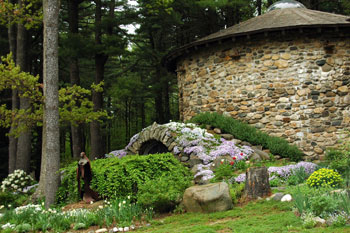 In mixing concrete, and building the walls stone by stone, the community members formed bonds with one another that laid the foundation for the formation of Lay communities centered in relationship to Regina Laudis. At that time of tremendous searching and experimentation within the Church, Pat considered it one of the defining gifts of her life to be formed as a member of a lay community with whom she continues in committed relationship today. Against the background of so much questioning of all traditional values, she could see within the peace of the monastery, a glimpse of transcendence that offered a resolution for the discontinuity and disconnection of her generation. She believed it was not a utopian dream, but a path worth pursuing, no matter how challenging it might be or what the cost. In mixing concrete, and building the walls stone by stone, the community members formed bonds with one another that laid the foundation for the formation of Lay communities centered in relationship to Regina Laudis. At that time of tremendous searching and experimentation within the Church, Pat considered it one of the defining gifts of her life to be formed as a member of a lay community with whom she continues in committed relationship today. Against the background of so much questioning of all traditional values, she could see within the peace of the monastery, a glimpse of transcendence that offered a resolution for the discontinuity and disconnection of her generation. She believed it was not a utopian dream, but a path worth pursuing, no matter how challenging it might be or what the cost.ENTRANCE AND EARLY YEARS AT REGINA LAUDIS 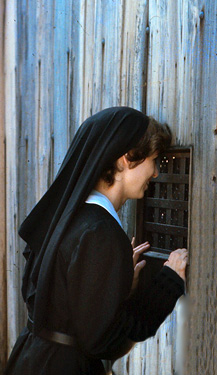 God revealed Himself slowly to her, but her path eventually led Pat to ask to enter Regina Laudis. “Not until you finish that dissertation!” was the answer. She entered on September 1, 1979 after finishing her dissertation and enjoying a whirlwind trip to Europe with her friend Margaret Patton, now Mother Margaret Georgina Patton, O.S.B. and the newly appointed Subprioress of Regina Laudis. After a brief time at Our Lady of the Rock Priory, on Shaw Island, Pat settled into a life of cooking and cheese-making, progressing to the point of petitioning to be clothed in the monastic habit, which she was on December 17, 1980, receiving the name "Sister Lucia, " a name she cherishes. God revealed Himself slowly to her, but her path eventually led Pat to ask to enter Regina Laudis. “Not until you finish that dissertation!” was the answer. She entered on September 1, 1979 after finishing her dissertation and enjoying a whirlwind trip to Europe with her friend Margaret Patton, now Mother Margaret Georgina Patton, O.S.B. and the newly appointed Subprioress of Regina Laudis. After a brief time at Our Lady of the Rock Priory, on Shaw Island, Pat settled into a life of cooking and cheese-making, progressing to the point of petitioning to be clothed in the monastic habit, which she was on December 17, 1980, receiving the name "Sister Lucia, " a name she cherishes.Soon it became clear that her main area of attraction and aptitude was as assistant to the Cellarer, Abbess Emerita David, who was then Prioress. Abbess David formed Sister Lucia in the demanding and relentless work of the oversight and management of the Abbey’s buildings, the number of which would over time grow to exceed thirty, all in various states of need and disrepair. Gradually she took on increased responsibility for maintenance and utilities; recycling; building renovations and restorations; distribution of supplies; daily housecleaning, and assistance to any other monastic department in need, such as the kitchen where she served as “Econome” from 1994-2001. Something I realized, full force, on the first day Pat entered, was how happy this place made her. Talking with her for the first time as she stood and sat on the other side of the grille, in Saint Placid’s parlor, I sensed relief, joy, radiance...as if she had found her place at last. It might sound funny, but as soon as she entered, I started to realize how wild her spirit actually was, how free, how funny and deep and filled with amazing, radiant perspective. As she grew at the Abbey, she grew more and more...herself!
Harriet Scott Chessman, Mother Abbess' beloved friend and fellow Yale graduate student
PROFESSIONAL LIFE IN THE ABBEY  Sister Lucia made First Vows on August 6, 1985 and five years later became "Mother Lucia" when she made Final Profession of Vows on December 17, 1990. She received the Blessing of Consecration with eight other of her peers on the Feast of St. Benedict, July 11, 1998. In her vowed life, along with her work for the Cellarer, the place of greatest maternal fruitfulness has not surprisingly been in the area of her studies. When someone with a particular professional or academic competence enters the Abbey, there is always the bedeviling question of how she will be able to use that gift to serve the community because she can no longer do it directly or on her own terms as she once did. Although to her great joy she occasionally was asked to be a consultant to Shakespeare productions at the Abbey's The Gary-The Olivia Theater, it seemed hard at first to believe her academic past was not simply in the past. However, from the beginning, Lady Abbess did not let her forget that she had to use her mind and keep learning, encouraging her to study St. Augustine and the Church Fathers, so that her commitment to the Cellarer’s Department was complemented by an equal commitment to put her training as educator, teacher and writer at the service of the community. Again, Mother Dolores Hart was tireless in helping to find the contexts where these gifts could be operative. Sister Lucia made First Vows on August 6, 1985 and five years later became "Mother Lucia" when she made Final Profession of Vows on December 17, 1990. She received the Blessing of Consecration with eight other of her peers on the Feast of St. Benedict, July 11, 1998. In her vowed life, along with her work for the Cellarer, the place of greatest maternal fruitfulness has not surprisingly been in the area of her studies. When someone with a particular professional or academic competence enters the Abbey, there is always the bedeviling question of how she will be able to use that gift to serve the community because she can no longer do it directly or on her own terms as she once did. Although to her great joy she occasionally was asked to be a consultant to Shakespeare productions at the Abbey's The Gary-The Olivia Theater, it seemed hard at first to believe her academic past was not simply in the past. However, from the beginning, Lady Abbess did not let her forget that she had to use her mind and keep learning, encouraging her to study St. Augustine and the Church Fathers, so that her commitment to the Cellarer’s Department was complemented by an equal commitment to put her training as educator, teacher and writer at the service of the community. Again, Mother Dolores Hart was tireless in helping to find the contexts where these gifts could be operative.Now the ways are almost too numerous to mention. As coordinator of the Monastic Studies Program from 1985 to the present she has been responsible for the ongoing educational development of the community, including teaching classes on Monastic History, St. Augustine, and the Rule of St. Benedict. Through collaboration with Shakespearean and Monastic Scholar Dr. Deborah Curren-Aquino of the Folger Shakespeare Library, she was actually able to study and teach Shakespeare again with the community. 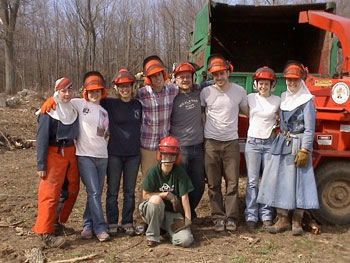 As monastic librarian she has been responsible for assisting the Abbess in developing the monastic reading programs for the refectory and for specific lectio studies during Lent or times of retreat. Her educational outreach includes sponsoring community seminars, and workshops with visiting scholars; advising Abbey students pursuing higher degrees or professional accreditations; and serving as faculty adviser to students in Self-Designed Master’s and Doctoral Programs. Since 1990 Mother Lucia has been a liaison with local colleges and universities, hosting seminars and conferences for student groups who come for a “monastic experience” of prayer and work on the land. Such groups have visited from Mount Holyoke, Trinity College, University of Connecticut, Villanova and Yale University. As monastic librarian she has been responsible for assisting the Abbess in developing the monastic reading programs for the refectory and for specific lectio studies during Lent or times of retreat. Her educational outreach includes sponsoring community seminars, and workshops with visiting scholars; advising Abbey students pursuing higher degrees or professional accreditations; and serving as faculty adviser to students in Self-Designed Master’s and Doctoral Programs. Since 1990 Mother Lucia has been a liaison with local colleges and universities, hosting seminars and conferences for student groups who come for a “monastic experience” of prayer and work on the land. Such groups have visited from Mount Holyoke, Trinity College, University of Connecticut, Villanova and Yale University. From 1988 to the present, Mother Lucia has been Director of the Monastic Internship Program, which she considers one of her most rewarding and hopefully lasting accomplishments. The Monastic Internship is open to men and women seeking to spend a year at the Abbey to participate in the work and prayer of the community. In many ways she considers this the fulfillment of her life-long desire for experiential learning, for education that addresses body, mind, and spirit. From 1988 to the present, Mother Lucia has been Director of the Monastic Internship Program, which she considers one of her most rewarding and hopefully lasting accomplishments. The Monastic Internship is open to men and women seeking to spend a year at the Abbey to participate in the work and prayer of the community. In many ways she considers this the fulfillment of her life-long desire for experiential learning, for education that addresses body, mind, and spirit.
NEW HORIZONS RENOVATION PROJECT 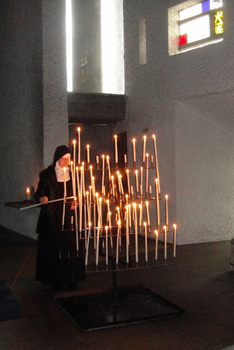 In October 2009 Mother Lucia had the once in a life time opportunity to go with Mother Telchilde Hinckley, O.S.B. to the Church of Notre-Dame du Haut, in Ronchamp, France. Mother Lucia was deeply affected by the sense of the sacred and the light in this church, designed by the French modernist architect Le Corbusier. This trip turned out to be a turning point in Mother Lucia’s monastic life. She returned personally renewed and with a new sense of hopefulness about the abbey’s seemingly insoluble building problems. She had the glimmer of an idea for a way forward. In October 2009 Mother Lucia had the once in a life time opportunity to go with Mother Telchilde Hinckley, O.S.B. to the Church of Notre-Dame du Haut, in Ronchamp, France. Mother Lucia was deeply affected by the sense of the sacred and the light in this church, designed by the French modernist architect Le Corbusier. This trip turned out to be a turning point in Mother Lucia’s monastic life. She returned personally renewed and with a new sense of hopefulness about the abbey’s seemingly insoluble building problems. She had the glimmer of an idea for a way forward.The following year 2010, her Jubilee Year celebrating 25 years of Vowed Life, Mother Lucia presented Abbess David and the Monastic community with a vision that she had been nurturing in her heart, that of undertaking a renovation of part of our original monastic complex. She suggested that while we were in the complex process of determining whether we could undertake building a completely new monastery on the hill, why not simply start to renovate part of the original monastery? We all knew it was in dire shape and held a lot of wasted space that was desperately needed. The sixty-five year-old factory building purchased by our Foundress in 1948 could no longer contain the life of our community. We needed more monastic cells, more office and studio space, and perhaps most pressing, accessibility to ensure the quality of life and independence of our elders. This proposal marked another defining moment for Mother Lucia and would completely absorb her time and energy in the years to come. We knew in our hearts we would never just abandon the old monastery. The labor and love of those who had suffered and struggled to bring it into being had made it too sacred a space. The prayers of over 60 years are embedded in its walls.
Mother Abbess Lucia, New Horizons Project Manager
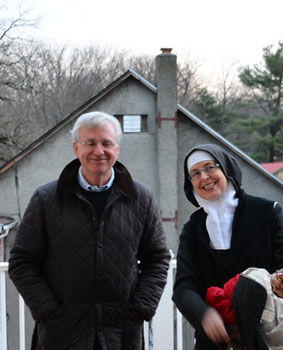
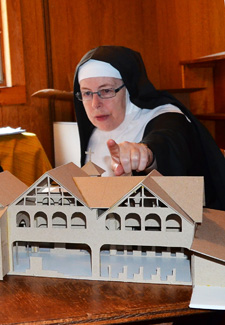 All of these overwhelming practical considerations eventually led to a comprehensive plan, a vision for the whole Lower Monastery, developed in collaboration with architect Paul Maggi, who was recommended by Mother Abbess' sister Mary and her brother-in-law Don Larson. Their enthusiastic support for the project gave not only Mother Lucia, but the whole community the confidence to move forward. With the help of countless friends and donors and the miraculous grace of God, on July 11, 2013, the Feast of St. Benedict, the community was able to gather in the beautiful library extension to bless the completion of Phase I of the project, and almost immediately began planning for Phase II. All of these overwhelming practical considerations eventually led to a comprehensive plan, a vision for the whole Lower Monastery, developed in collaboration with architect Paul Maggi, who was recommended by Mother Abbess' sister Mary and her brother-in-law Don Larson. Their enthusiastic support for the project gave not only Mother Lucia, but the whole community the confidence to move forward. With the help of countless friends and donors and the miraculous grace of God, on July 11, 2013, the Feast of St. Benedict, the community was able to gather in the beautiful library extension to bless the completion of Phase I of the project, and almost immediately began planning for Phase II.As so often happens in life, the successful completion of one goal reveals twice as much more to be done, but the timing seems choreographed by the Holy Spirit. On February 1, 2015 Reverend Mother Lucia Kuppens, O.S.B. was elected the third Abbess of the Abbey of Regina Laudis. Her election coincides precisely with the community’s need to face the challenges that await us in Phase II of the building project. But the Community has never been stronger and more ready for such a challenge. With Mother Olivia-Frances Arnold, Prioress, O.S.B. and Mother Margaret Georgina Patton, Subprioress, O.S.B., working closely at her side, the Council, the Deans and each gifted member of the community in her domain, Mother Abbess Lucia feels Regina Laudis is in the perfect position to face the uncertain future, believing with St. Scholastica: Plus potuit quia plus amavit!
She was able to do more because she loved more! ABBATIAL BLESSING On May 10, 2015, the Sixth Sunday of Easter, Mother Abbess Lucia received the Monastic Rite of Blessing from the hands of His Excellency the Most Reverend Leonard P. Blair, S.T.D., Archbishop of Hartford.
SOLEMN PRAYER OF BLESSING
Almighty God and Father, you sent your only Son into the world to minister
to mankind, and, as the good shepherd, to give his life for his sheep. Suppliant,
we beseech you to bless and strengthen your servant Lucia, chosen to
be abbess of this monastery. Grant that through the shining example of her
monastic way of life, she may show herself to be what she is called; and let
her know that it is her duty rather to profit her sisters than to preside over
them. Therefore, under your inspiration, let her exercise the greatest solicitude;
and let her always temper and arrange all things so that all, continually
advancing in the love of Christ and fraternal charity, may with enlarged
hearts hasten along the way of your commandments. Deign to fill her with
the gift of your Spirit, O Lord, that she may be inflamed with love for your
glory and the service of the Church and unceasingly impel her sisters likewise.
Let her prefer nothing whatever to Christ, that when He comes on the last
day, she may merit to attain your kingdom together with her sisters. Through
Our Lord Jesus Christ your Son, who lives and reigns with you in the unity
of the Holy Spirit, God, forever and ever. Amen. IN THE WORDS OF MOTHER ABBESS LUCIA: RESPONSE TO THE YEAR OF CONSECRATION
There are no coincidences. That the Abbatial Blessing was to take place within the year Pope Frances dedicated to Consecrated Life certainly amplified our awareness of his challenge to consecrated men and women to 'Wake up the world!' As we drew closer to the blessing, I kept asking myself what that could possibly mean for us as contemplatives.
Then in relation to Holy Thursday and the washing of the Apostles’ feet, a passage from Shakespeare came back to me: When thou dost ask me blessing I’ll kneel down and ask of thee forgiveness And so we’ll live and sing and pray… And take upon us the mystery of things As if we were God’s spies… (King Lear, Act V, iii) This phrase 'the mystery of things' is a great puzzle to many people, but not I think to those who live in a monastery, where life is extraordinarily rich in the 'mystery of things,' rich in terms of matter brought forward to be blessed, rich in the flood of sacramentality that surrounds us. One could almost say that monastic life is not only a Consecrated Life but a consecrating life. Too often the phrase consecrated life seems to conjure up images of being relegated to a pedestal, a life remote from the world. A consecrating life on the other hand conveys a sense of constant action, of taking the things of this world and lifting them up to God, helping others come to God through creation. There is nothing made sacred without the giving of one’s body and blood for it in identification, love, and sacrifice. We can see that mystery here in the land of Regina Laudis because we live immersed in the pulsing rhythms of life and death that always culminate for us in the celebration of the Eucharist. The challenge for us as contemplatives it seems to me is always to be alert to how we can bring more to the altar of blessing, more of life as it presents itself, however imperfect or improbable. If we can live a consecrating life, I think we can truly 'wake up the world' to the gift of Creation and help restore it in its goodness and innocence to the God who made it to be enjoyed not just by a few, but by all. THE ABBATIAL INSIGNIA
Our Foundress, Lady Abbess Benedict Duss, brought the tradition of European monasticism to American soil from Notre Dame de Jouarre in France in 1948. As second Abbess of Regina Laudis, Abbess David Serna, herself of Peruvian descent, accented the Formation and Education of the first American generation at Regina Laudis. Mother Abbess Lucia considers herself privileged to have been formed directly by these two founding Abbesses and felt it was a natural progression in the line of succession to celebrate how our experience of living and working on this specific land in Bethlehem, Connecticut, has now formed and continues to inform our present community. THE RING  The Abbatial ring is the prime symbol of the covenantal bond between the Abbess and her community. The Abbess’ obligation for the ongoing life of each member of the
community and for the community as a whole demands a level of unceasing care and vigilance: the ring signifies the intimacy and strength of this bond. The prayer of blessing refers to the ring as a “seal of fidelity,” and calls on God to aid the Abbess’ human frailty in fulfilling
her awesome obligation. The Abbatial ring is the prime symbol of the covenantal bond between the Abbess and her community. The Abbess’ obligation for the ongoing life of each member of the
community and for the community as a whole demands a level of unceasing care and vigilance: the ring signifies the intimacy and strength of this bond. The prayer of blessing refers to the ring as a “seal of fidelity,” and calls on God to aid the Abbess’ human frailty in fulfilling
her awesome obligation.The genesis of this particular ring began with Mother Abbess Lucia’s asking the question: “Would it be possible to have the stone for the ring come from this land?” This began a process of inquiry and discovery clearly led by the Holy Spirit. Not only did we learn that our land is home to the almandine garnet, the state mineral of Connecticut, but we had among the archives a piece of rough igneous rock with what appeared to be garnets embedded within it. Miraculously, we were able to call on a professional jeweler with the capacity to extract the garnets from the rock. Isabelle Zifcak, a member of the same Lay Oblate community, the Closed Community, that Mother Abbess Lucia has been part of for over forty years, leapt for the mission. What emerged from the rock were four garnets of different sizes, each with a perfect crystalline shape and dark reddish-brown color. Though a humble stone, the garnet has an ancient lineage. Albertus Magnus first named it “garnata” in the thirteenth century and it is often referred to in Scripture as a “carbuncle” because it was thought to look like a small burning coal. In different lights the color evokes association with earth, wine, or blood, all rich and meaningful references for monastic life. The monastic custom of kissing the abbess’ ring whenever someone leaves or re-enters the enclosure takes on a new meaning in light of the matter of the ring itself being a piece of “home,” a fragment of earth from the very place to which the community has vowed Stability. With the assistance of Mother Telchilde Hinckley, O.S.B., and the wonders of digital technology, Isabelle was able to work from Portland, Oregon to design a silver ring that would hold the largest of the garnets and with the help of a trusted colleague fabricate the ring and matching pectoral cross. THE PECTORAL CROSS  The pectoral cross makes the Abbess visible to all as one who is identified with the
person of Christ. Thus in complement to the ring, which holds the intimacy of the bond
with the community, the cross speaks of the public witness and mission to conform our
lives to Christ’s Passion, Death and Resurrection. This cross is a modified Benedictine cross made in silver and encloses at its center two interlocking silver spirals. In exploring the
design, the spiral emerged as an ancient motif found on a Celtic processional cross that in its many variations can signify: the breath of life, the Holy Spirit, eternity, the cosmos, and the union of opposites. The spiral appears everywhere in nature from an immense supernova in the most remote galaxy to the tiniest seashells. It has been used to express both the dynamism of the creation of the world and, at the opposite end of the scale, the conception of a single human life. The pectoral cross makes the Abbess visible to all as one who is identified with the
person of Christ. Thus in complement to the ring, which holds the intimacy of the bond
with the community, the cross speaks of the public witness and mission to conform our
lives to Christ’s Passion, Death and Resurrection. This cross is a modified Benedictine cross made in silver and encloses at its center two interlocking silver spirals. In exploring the
design, the spiral emerged as an ancient motif found on a Celtic processional cross that in its many variations can signify: the breath of life, the Holy Spirit, eternity, the cosmos, and the union of opposites. The spiral appears everywhere in nature from an immense supernova in the most remote galaxy to the tiniest seashells. It has been used to express both the dynamism of the creation of the world and, at the opposite end of the scale, the conception of a single human life.
 But paradoxically, only the cross, the Tree of Life, has the power to enclose and
redeem the swirling energy of creation, which left to itself can spiral out of control. The design reminds us that the ultimate truth of the cross is eternal life, not death. The garnet, placed right in the center of the cross where the spirals meet, can be seen as the Sacred Heart of Christ sustaining the heart of the universe, and the heart of each person. The cross is blessed by the Archbishop privately before Mass so that the new Abbess can wear it during the ceremony. But paradoxically, only the cross, the Tree of Life, has the power to enclose and
redeem the swirling energy of creation, which left to itself can spiral out of control. The design reminds us that the ultimate truth of the cross is eternal life, not death. The garnet, placed right in the center of the cross where the spirals meet, can be seen as the Sacred Heart of Christ sustaining the heart of the universe, and the heart of each person. The cross is blessed by the Archbishop privately before Mass so that the new Abbess can wear it during the ceremony.THE CROZIER  The crozier is an ancient symbol of authority in the Church and in Benedictine
communities that derives from the almost universal experience of watching shepherds
pasturing their flocks. Everyone in the Palestine of Christ’s day would have known exactly what Christ meant when he said, “I am the Good Shepherd.” In the solemn prayer of blessing that the Bishop recites over the Abbess, the first reference to Christ is as “the Good Shepherd who lays down his life for his flock.” The ceremony of the Blessing of an Abbess dates from the seventh century, and the bestowal of the crozier, or pastoral staff, has been revered in Benedictine tradition since that time. St. Benedict himself uses the reference of
the Shepherd and flock throughout the Rule to describe the relationship of the Abbot to the community.
Unlike the bishop, the Abbess holds her crozier with the crook facing in, symbolizing that her authority is given first and foremost in relation to governing and guiding her community. Her bond with this flock is intimate and personal. As Shepherd, it is her solemn responsibility to leave the ninety-nine, again and again if necessary, and go after the one sheep that has strayed. As an extension of the shepherd’s outstretched arm, the staff is
used for protecting the flock, fighting off predators, gathering the sheep together, leading and pointing the way, catching and bringing back the stray. All these uses hold true for the Abbess by analogy. Thus the crozier is preeminently an emblem of trust between the Abbess and those whose care she has undertaken. The crozier is an ancient symbol of authority in the Church and in Benedictine
communities that derives from the almost universal experience of watching shepherds
pasturing their flocks. Everyone in the Palestine of Christ’s day would have known exactly what Christ meant when he said, “I am the Good Shepherd.” In the solemn prayer of blessing that the Bishop recites over the Abbess, the first reference to Christ is as “the Good Shepherd who lays down his life for his flock.” The ceremony of the Blessing of an Abbess dates from the seventh century, and the bestowal of the crozier, or pastoral staff, has been revered in Benedictine tradition since that time. St. Benedict himself uses the reference of
the Shepherd and flock throughout the Rule to describe the relationship of the Abbot to the community.
Unlike the bishop, the Abbess holds her crozier with the crook facing in, symbolizing that her authority is given first and foremost in relation to governing and guiding her community. Her bond with this flock is intimate and personal. As Shepherd, it is her solemn responsibility to leave the ninety-nine, again and again if necessary, and go after the one sheep that has strayed. As an extension of the shepherd’s outstretched arm, the staff is
used for protecting the flock, fighting off predators, gathering the sheep together, leading and pointing the way, catching and bringing back the stray. All these uses hold true for the Abbess by analogy. Thus the crozier is preeminently an emblem of trust between the Abbess and those whose care she has undertaken.The staff of this crozier is made from a piece of oak found appropriately on the portion of Abbey land known as “Sheepfold”. Providentially, the wood was set aside for a possible walking stick, which meant that it had been aging for a while when the word went out that we were looking for wood for the Abbatial crozier. The wood was “drawn down” to a smooth finish by Mother Anastasia Morgan, O.S.B., and her many assistants at the Abbey Blacksmith Shop. The “custom design” is evident in the way one of the nodes where a branch used to be now serves as the perfect hand rest. The crook is actually the horn of one of our Shetland ram lambs, named Papa John. Mother Alma Egger, O.S.B., artist and shepherd, soaked and molded the horn to fit snugly on the staff. Then came the challenge of joining the two pieces together for which we needed to call on the skills of a local artist and jeweler. This design picks up the silver of the cross and ring, as well as the motif of the Celtic spiral. Where the horn and wood come together, on the side of the crozier facing the Abbess, is the third piece of garnet, a subtle but beautiful reminder of how the ring, cross and crozier are all related in function and design.
SIGNIFICANCE OF MOTHER ABBESS LUCIA'S COAT OF ARMS Historically, each succeeding abbess is privileged to have a Coat of Arms, an oval shield bearing the iconic symbols that represent her genealogy and the accent of her particular tenure as abbess. These symbols were chosen by Mother Abbess Lucia for the reasons she describes below. The book symbolizes my maternal ancestry, one hundred percent Irish, from Galway in the
west of Ireland. A strong Celtic influence permeated my home. From these roots I received my love
of the word, of poetry, of learning, education, culture, and music. The book could be interpreted to
represent Scripture, or The Rule, literature itself or the works of Shakespeare, the particular focus
of my doctoral dissertation. On a practical level, the book refers to much of my work in the Abbey,
which includes supporting others in their studies, hosting student groups, directing the Monastic
Internship Program, and when called for, writing about the Abbey. My Clothing and Profession
ceremonies were both on the Advent feast of “O Sapientia” in celebration of Wisdom. The book is
open, conveying the imagination and intellect open to the Wisdom of the Holy Spirit. The roof truss at the top of the shield symbolizes my paternal ancestry. The dominant national identity in my father’s family was Alsatian, from northeastern France, just a stone’s throw from the German border. They were a people who suffered and survived much in war, as their borders continually changed. From my father’s family comes a rootedness in the earth, an appreciation of manual work, a respect for practical solutions and love for what is essential in life. From him comes my attraction to the other main area of my monastic service, the Cellarer’s Office. Until fairly recently my father worked all over the Abbey helping repair and build things. Through my involvement with a Lay Oblate Community (The Closed Community) prior to entering the Abbey, I had many experiences of participating in building on the Abbey land, notably the Chapter House on the Hill. Since 2009 I have been working with others to renovate the original monastic buildings and envision this being a major work for the whole community for the next ten years. Continuity with Lady Abbess and Abbess David is represented by the wavy line in the center that marks the pine hill, which was on both of their shields as well. The hill is the central feature of our land. It is where our church was built and it represents the spiritual center and heart of the monastery. The three stars, which also appeared on Abbess David’s shield represent the continued commitment to build the triadic nature of our authority structure composed of Abbess, Prioress, and Subprioress. The consecration lamp is an ancient and rich symbol of consecrated virginity and therefore seemed an apt symbol for representing the light of St. Lucy, Virgin and Martyr. Each nun receives such a lamp, made by our potter, at the time of her Consecration, when the church bestows its blessing and affirmation on the fruitfulness of her vows. The burning oil lamp symbolizes the gift of self, consumed in the fire of love. Two flames rise from this lamp symbolizing for me that the gift of one’s love to Christ is never solitary, but is given in relationship to others. The consecration lamp unifies the whole shield, mediating between the speculative and practical polarities of my genealogy and bringing our attention to the meaning of the motto, which is taken from the Office of St. Scholastica, sister of St. Benedict and a consecrated virgin. As told in the Dialogues of St. Gregory the Great, one night she prevailed on her brother to disobey his Rule and instead of returning to his monastery, stay with her talking and praying. Though she did not tell him why, she knew her death was near. He refused her, but her tears of supplication to God caused a sudden storm that prevented St. Benedict from leaving. Thus in that moment, she prevailed over him and St. Gregory says of her, 'Plus potuit quia plus amavit,' which is translated: 'She was able to do more because she loved more.' The banner of the motto embraces the whole shield and all the symbols on it, signifying that all we do is possible only through love and the grace of God. The scrolled ends of the banner echo the Celtic motif of the spiral that appears on the pectoral cross, crozier and Oath of Fidelity. This shield was designed by Mother Alma Egger, O.S.B. The blazon was composed by Deacon Paul J. Sullivan. THE CANDLE It is the custom of Regina Laudis that at the time of the Abbatial Blessing a candle is made for the Abbess and marked with her Coat of Arms and the Coat of Arms of the Archbishop who is conferring the blessing. This commemorative candle was made by Andrew Bannon-Guasp, Monastic Intern studying candle making with Mother Lioba Postel, O.S.B. It is made of 60% golden beeswax from our hives and is the color of butter cream. The candle is set in a candle holder of cherry and maple designed and hand-turned by local craftsmen. FEAST OF ST. SCHOLASTICA, FEBRUARY 2016 February 1, 2016 was the 1st anniversary of Mother Abbess Lucia's election as the 3rd Abbess of Regina Laudis. As we celebrated the Feast of St. Scholastica this year (moved to February 11th because of Ash Wednesday on the 10th) we were reminded that Mother Abbess chose the motto for her Coat of Arms from the Office of St. Scholastica. 'Plus potuit quia plus amavit' (She was able to do more because she loved more.) On this occasion we share Mother Abbess' Prayers of the Faithful for the Feast as well as the galleries of her Abbatial Blessing. 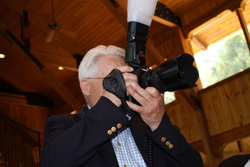 The Abbey extends special thanks to photographer Robert Fenton Houser for the generous gift of his time and expertise in photographing Mother Abbess Lucia's Abbatial Blessing in May 2015. Today through Robert's photographs may you to savor the grace and joy of that celebration.
May the rare convergence this year of Ash Wednesday, The World Day of Prayer for the Sick, and the Feast of St. Scholastica, help us to remember that essentially the reason we are called to penance and conversion of heart is to make more room within us for love. Let us Pray to the Lord Plus Potuit Quia Plus Amavit—She could do more because she loved more. May we renew our efforts to live under this challenging banner of St. Scholastica, never despairing over our own impoverished resources when it come to loving our sister or brother, but trusting that Christ, who loves us all, will give the grace that is needed. Let us Pray to the Lord. Mother Abbess' Prayer of the Faithful, Feast of St. Scholastica 2016
GALLERY OF MOTHER ABBESS LUCIA'S ABBATIAL BLESSING, MAY 10, 2015 PHOTOGRAPHS BY ROBERT FENTON HOUSER Before Mass Archbishop Leonard Blair blesses Mother Abbess' cross and ring.
The Monastic Community enters Choir.
Procession—Bells ring as Archbishop Blair and celebrants meet Monastic Community.
The Archbishop blesses Mother Abbess.
Liturgy of the Word with chanting by Monastic and Oblate Choirs.
RITE OF BLESSING Presentation of Mother Abbess Lucia to Archbishop Blair by Abbess David, Abbess Emerita, Homily of Archbishop Blair, Examination, and Litany of the Saints during Prostration. Most Reverend Father, in the name of our community we present to you the
Abbess-elect of our monastery of Regina Laudis, of the Order of our Holy
Father Saint Benedict, in the Archdiocese of Hartford. We humbly ask you to
bless her as Abbess of our monastery.
Solemn Prayer of Blessing, Bestowal of the Ring and Crozier.
Almighty God and Father, you sent your only Son into the world to minister
to mankind, and, as the good shepherd, to give his life for his sheep. Suppliant,
we beseech you to bless @ and strengthen your servant Lucia, chosen to
be abbess of this monastery. Grant that through the shining example of her
monastic way of life, she may show herself to be what she is called; and let
her know that it is her duty rather to profit her sisters than to preside over
them. Therefore, under your inspiration, let her exercise the greatest solicitude;
and let her always temper and arrange all things so that all, continually
advancing in the love of Christ and fraternal charity, may with enlarged
hearts hasten along the way of your commandments. Deign to fill her with
the gift of your Spirit, O Lord, that she may be inflamed with love for your
glory and the service of the Church and unceasingly impel her sisters likewise.
JOYFUL CELEBRATION AT THE JUBILEE BARN
Beloved parents Eleanor and Frank Kuppens, and wonderful Kuppens Family.
Entertainment—a short play "The Mystery of Things" put on by Mother Abbess' colleagues, Abbey friends and community members, based on a quote beloved to Mother Abbess Lucia: When thou dost ask me blessing, I’ll kneel down
And ask of thee forgiveness. So we’ll live, And pray, and sing, and tell old tales, and laugh At gilded butterflies, and hear poor rogues Talk of court news; and we’ll talk with them too— Who loses and who wins; who’s in, who’s out— And take upon ‘s the mystery of things, As if we were God’s spies… King Lear, Act V, iii
The play ended with a rousing rendition of Non Nobis Domine by Patrick Dolye
sung by a flash mob conducted by Ken Steen. A cheer from Mrs. Kuppens: Here, here!
Priests, Religious, Family and Friends came from near and far to share in the festivities.
Laetare Sunday—2nd Installment of photographs from the celebration
|
||||||||||||||||||||||||||||||||||||||||||||||||||||||||||||||||||||||||||||||||||||||||||||||||||||||||||||||||||||||||||||||||||||||||
| Copyright © 2013 Abbey of Regina Laudis. All rights reserved. | |||||||||||||||||||||||||||||||||||||||||||||||||||||||||||||||||||||||||||||||||||||||||||||||||||||||||||||||||||||||||||||||||||||||||